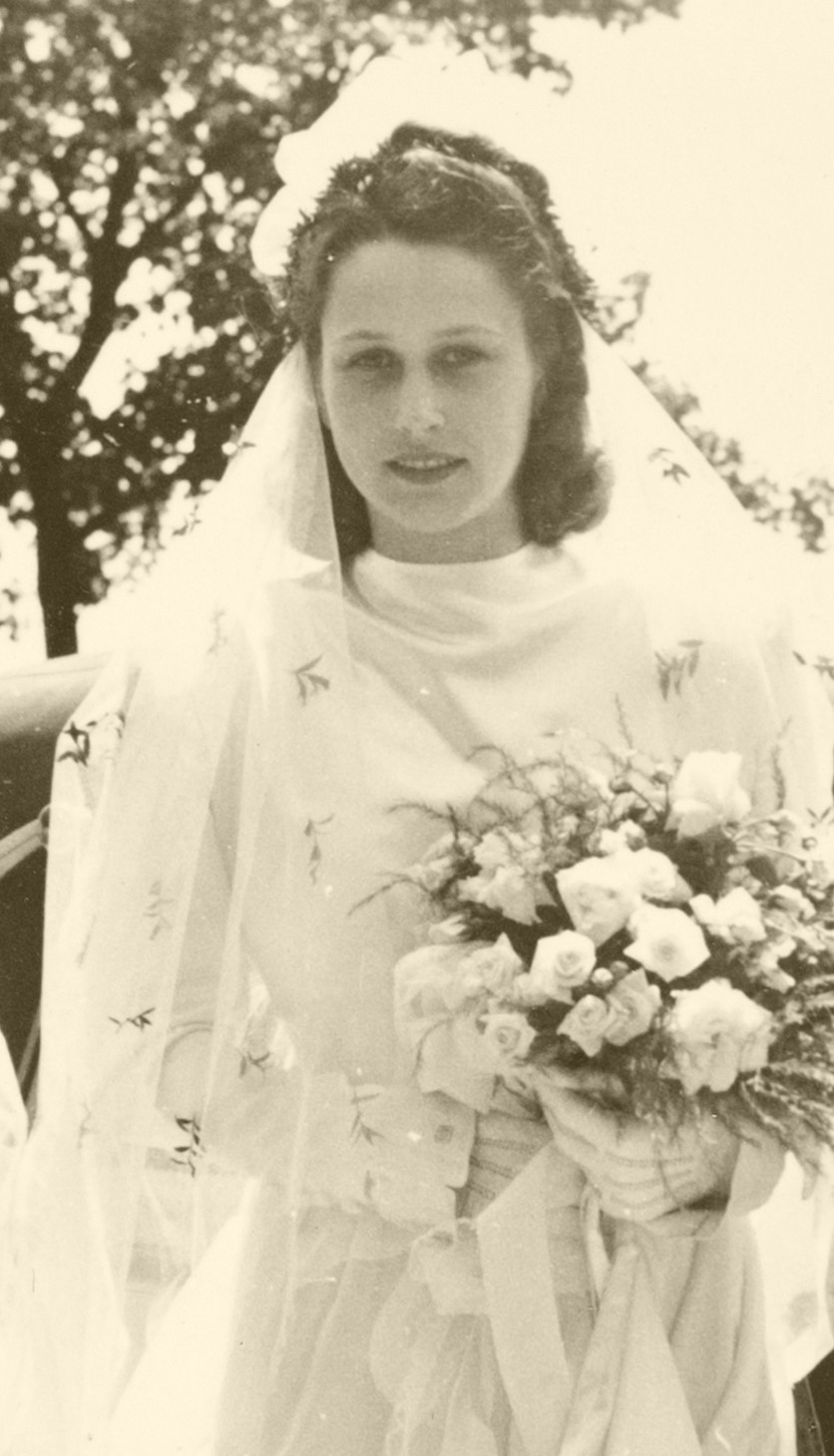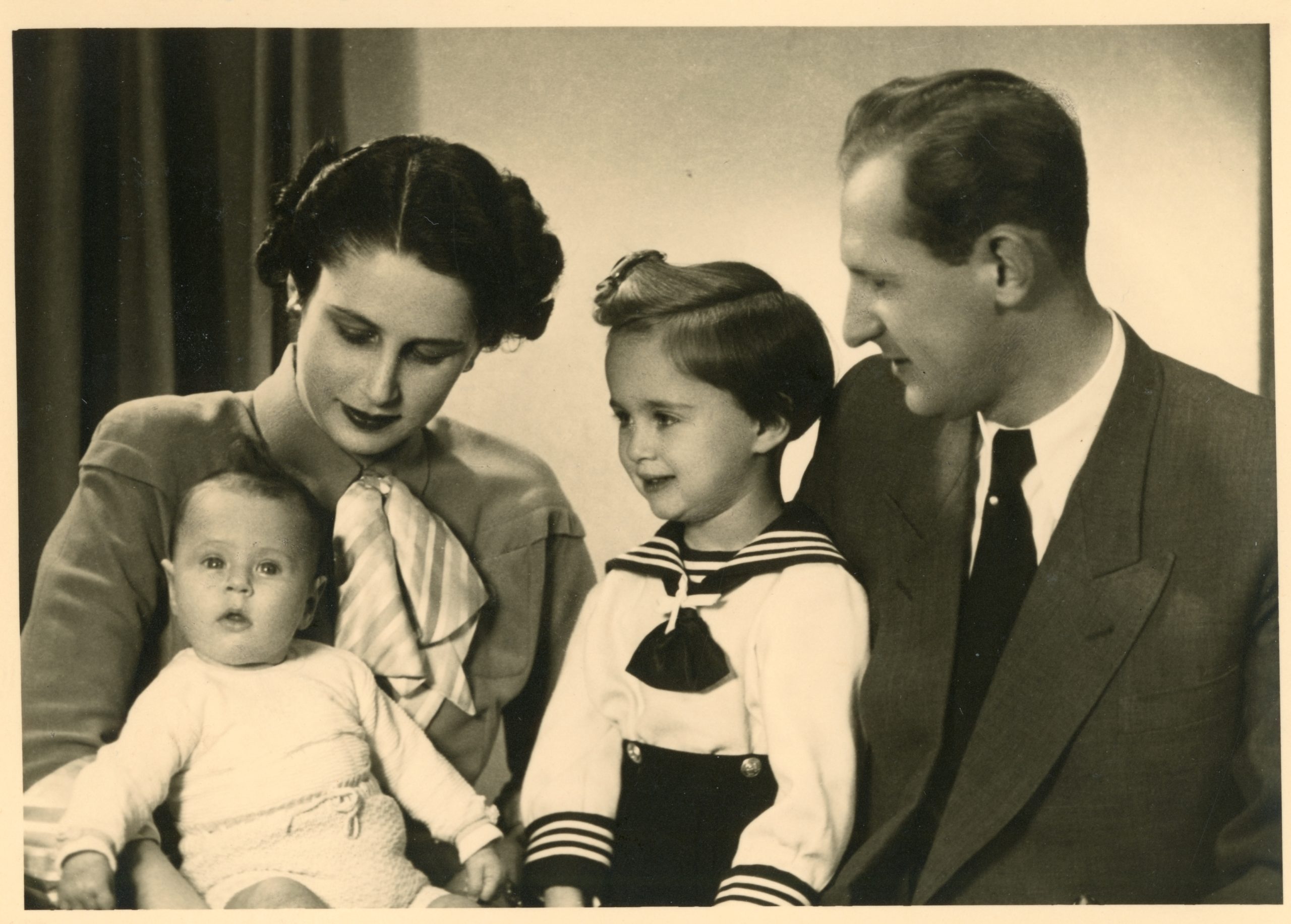On an autumn evening in 1944, a young man and woman meet behind the
Hamburg Barracks in the Terezin ghetto to take an evening walk, as is their
custom. Somehow, despite the terrible conditions of the ghetto, they
found each other, and their friendship quickly blossomed into love. Even
here love can thrive, in spite of tremendous odds and the constant threat
of transports to the unknown.
For many months they’ve been spared, but now the young man’s luck has run out and he’ll be leaving on a transport in the morning. Sensing he has nothing to lose, the young man leads his beloved to a walled garden, where wild roses beckon to them from beyond the wrought iron gate. The garden
is forbidden to them, but the young man climbs over the gate and searches the prickly branches until he finds a perfect pink rose. He presents the rose to the woman he loves, along with a picture of himself as a final gift to remember him by.
In just a couple more days, Schmuel Berger boards a transport to the East, and neither he nor Inge Katz know if they’ll ever see each other again. They both knew the risks of falling in love in Terezin, knew that they were on borrowed time, and still they made the courageous choice to love one another.
Ironically, if it hadn’t been for the war, they would have probably never met. Inge was born and raised in Bremen, Germany, the daughter of a successful businessman, while Schmuel grew up on a farm in a small Czech town. It was only after they were sent to Terezin that their paths crossed.
Inge and Schmuel’s love story is the focus of the book Roses in a Forbidden Garden:
A Holocaust Love Story, a compelling and powerful memoir written by
their granddaughter, Elise Garibaldi. The book details Inge’s early life,
including her family’s suffering at the hands of the Nazis, her time in Terezin,
and her experiences after the war.
Inge’s Life Before Terezin
Inge Katz, a strikingly pretty girl with dark hair and vivid green eyes, grew up in a close-knit and loving family consisting of her charming, handsome father, elegant mother, and Oma Rosa, her gentle, devout grandmother. From the time she was a young child, she had
a special bond with Ruthie Cohen, her cousin and best friend. Inge was more on the
quiet and reserved side, while Ruthie was outgoing and confident, and always looked out for Inge.
Under the Nazis, both girls experienced increasing persecution, and were eventually banned from attending school. A Christian woman offered them apprenticeships in her dress shop, and they eagerly accepted this opportunity. As their skills grew, Ruthie and Inge dreamed of opening their own dress shop one day, even as life became increasingly difficult.
During Kristallnacht, the Nazis broke into Inge’s home, smashing everything in sight, and jailing Inge’s father, Carl, for several weeks. Soon after, the family was forced to move into a cramped house in a dilapidated section of town.
They coped with the situation as best as they could, despite their tight living conditions and food shortages. But things changed forever in November 1941, when Inge, Ruthie, and their families were assigned to a transport East.
At the last moment, the Nazis removed Inge’s family from the transport, but Inge was heartbroken that she would be separated from Ruthie. She accompanied Ruthie and her family to the train, where she hugged Ruthie tightly and reassured her they would meet again soon. Choked with emotion, Inge waved to her cousin as the train took off, the wind blowing Ruthie’s long brown hair over her face. Inge stayed on the platform for a long time after the train departed, wondering if she would ever see Ruthie again.
Despite missing her cousin terribly, Inge, like the rest of her family, continued following her daily routine and tried to maintain a positive outlook. As the winter of 1942 dragged on, Inge often worried about Ruthie, and hoped she was safe and warm wherever she was. They’d never been apart for so long, and Inge just wanted to be reunited with her cousin and best friend.
The Transport to Terezin
Then in June 1942, right after her eighteenth birthday, Inge’s family received a summons to report for the next transport. Inge boarded a train to the unknown wearing her new skirt suit of soft brown wool, a birthday gift from her parents.
The train left them at an isolated station called Bauschowitz, and everyone on
the transport was forced to walk for two hours in the hot July sun until they arrived at Terezin. They were led to a large building to register and assigned to barracks. Their block leader, also a Jewish prisoner, took a liking to Inge and allowed her and her family to stay in a small room at the top floor of the building.
Inge’s family was grateful to be together, but that didn’t spare them from the unspeakably awful conditions in the camp. Dozens of people shared a single filthy outhouse, and they only had cold water from a pump to wash with. Their meals mostly consisted of watery soup with rotten vegetables, small loaves of bread, and “coffee” which was actually
a tasteless brown liquid made from grain.
Still, Inge’s grandmother insisted that the family pray together each night, and urged them not to turn their backs on God. Despite everything, Inge remained grateful that she, her parents, and her grandmother were together.
But Inge soon suffered two terrible losses. Immediately after arriving, Inge began searching for Ruthie, only to learn that no other transports from Bremen had ever arrived in Terezin. The news dashed Inge’s hopes that she would be reunited with her cousin.
And just two weeks after their arrival at Terezin, Inge’s grandmother passed away suddenly, leaving another gaping void in the lives of Inge and her parents. Despite their grief, they continued to pray together at night, knowing that’s what Oma Rosa would have wanted. Inge also attended religious services in the ghetto, determined to hold fast to her faith.
Few younger people attended these services, but during Yom Kippur prayers, Inge spotted two young men. One of the men was tall, blond, and extremely handsome, and impressed Inge with his reverence as he prayed. When he glanced up and met Inge’s eyes, she shyly looked away. But for many weeks that followed, she found herself hoping to meet him again.
Little did Inge realize that the young man was also taken by her, and was determined to find a way to meet her. It took him four months, but eventually he discovered that Inge worked in the records office and appeared outside the building one day. Speaking in Czech-accented German, he told Inge his name was Schmuel Berger and invited her to go for a walk with him after work.
The next afternoon, they walked through the streets of Terezin, getting to know each other. When Inge discovered that Schmuel worked in the bakery, she balked. Since food was so scarce in the camp, many young women threw themselves at men who worked in
the bakery or kitchens. For this reason, Inge worried it would damage her reputation to be seen with Schmuel. But Schmuel reassured Inge that she never had to worry when she was with him.
They continued to walk together in the evenings, and as the weeks went by Inge realized her mood was lifting, and even found herself beginning to enjoy life again.
On Inge’s nineteenth birthday, Schmuel presented her with two special gifts – a small cake and a tiny flowerpot with a single bright marigold in it. He’d secured the flower at a tremendous risk to himself, and Inge became choked with emotion when she held it in her hands. Even though keeping a plant was forbidden, Inge held onto that flower for many weeks.
As the months passed, their connection deepened, their love continued to grow, and Inge found herself dreaming of their future together. Then, in late September 1944,
Schmuel arrived for their walk deeply shaken, and told Inge he was assigned to the next transport. They tried to remain strong but were both devastated by the news, knowing it meant they would probably never see each other again.
The night before the transport left, they walked together one last time, and
Schmuel presented Inge with a perfect pink rose from the walled garden.
Inge’s world was shattered after Schmuel left, and she spent countless evenings thinking of him and fearing what he might be going through. Still, Inge held fast to the dim hope that one day they would be reunited.
Liberation and the Long Journey Home
Inge continued to hope after Terezin was liberated by the Russians in May 1945, and after she and her parents returned to Bremen to start rebuilding their lives.
But as months went by with no word from Schmuel, Inge’s parents began to worry about her, feeling she needed to move on instead of holding out hope for someone who would probably never return. Even so, Inge continued to search tirelessly to uncover information about Schmuel, but with no luck.
Then one day, in late summer 1945, Inge received a letter, written in handwriting that looked familiar, though she couldn’t quite place it. Her heart leaped when she opened the envelope and found a note from Schmuel, saying that he was on his way back to her. Scarcely able to believe it, Inge read his letter over and over until she was finally convinced it was real.

But as weeks and then months passed with no sign of
him, Inge began to fear he would never arrive. Then on New Year’s Day, 1946, Inge spotted Schmuel walking hesitantly up to the front door of her family’s apartment building and hurried to greet him. Both of them were overcome with a mix of joy and apprehension, wondering if their feelings for each other would still be the same.
But soon after Schmuel entered the apartment, he spotted the picture he had given Inge the night before he left Terezin. At that moment Schmuel knew Inge hadn’t forgotten him, and had been waiting for him all this time. And when he smiled at Inge and asked her to go for a walk, Inge knew he had been thinking of her and only her during the many months of suffering he’d endured in the Nazi concentration camps.
Together, arm in arm, they exited the apartment and walked through the streets of Bremen, free and together at last.
Schmuel and Inge’s story is a remarkable and inspiring tale of love and hope
that flourished in the most unimaginable of places, a Nazi ghetto and concentration camp.
Even though World War II was one of the darkest times in human history, it’s crucial
to remember the human side of the story, that many people still held onto their humanity, and continued to love and dream and hope for a better world. Through their remarkable story, Inge and Schmuel teach us the powerful lesson that pure love can endure in the face of insurmountable odds, and is capable of radiating hope and light in even the darkest times.

